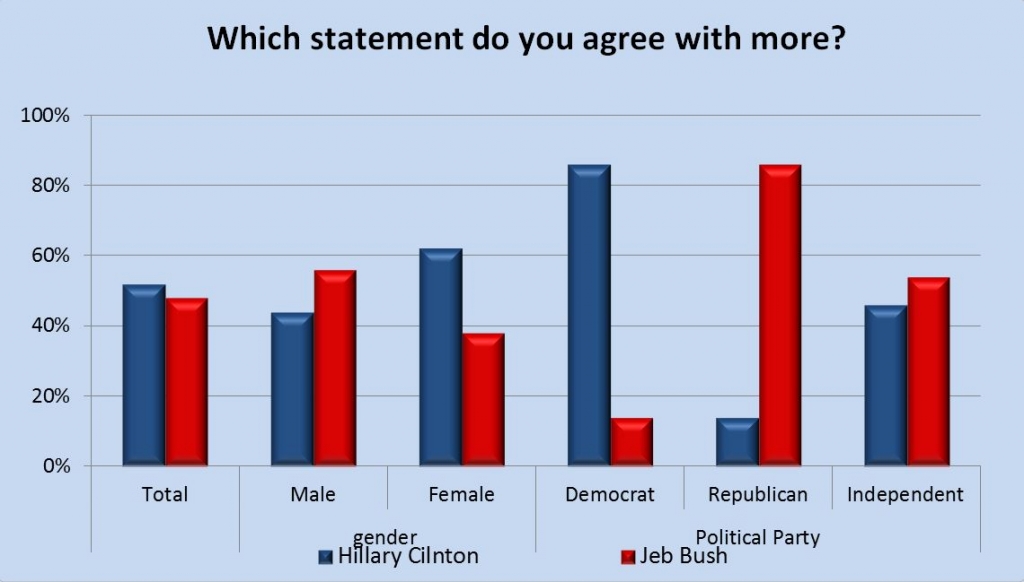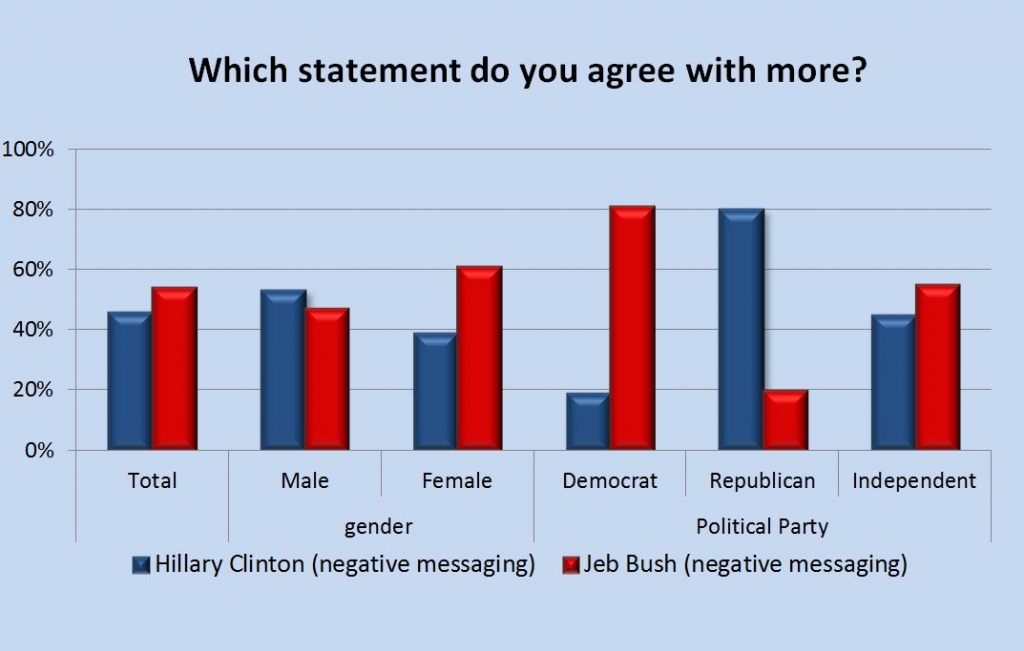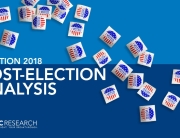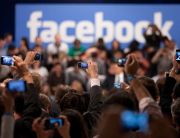By Bradley Honan, KRC Research
How do you get your product or idea sold? How do you grow market share? How do you simulate the likely impact of a campaign you want to run, before it’s developed?
Marketers, advertisers, communicators, and branding strategists grapple with these questions every day. What are you to do?
With the race to the White House in 2016 well underway, we decided in our most recent KRC Pulse Poll to test some messaging that could hypothetically be used by the Clinton and Bush camps – and both appear to need some help! We leveraged our firm’s extensive political message testing heritage and the experience of our team, many of whom have worked for leading politicians and elected officials domestically and around the globe. Full disclosure: KRC doesn’t do political work anymore.
We wanted to illustrate this for you to demonstrate what message testing is, how it works, and how it’s used.
What is Messaging?
Messaging are communications presented by those looking to define who they are and what they stand for. Messaging is regularly presented with the end goal of having a target audience associate products or companies with something.
Negative messaging, while not as commonly seen when it comes to companies and products, is a cornerstone of political communications. On the campaign trail, often equal amounts of effort are put into shaping negative opinions about the opponent as are applied to driving forward positive sentiments.
Candidates, brands, companies, and products also test negative messaging against themselves to determine how and where they are vulnerable – so they can effectively inoculate themselves in areas where they are weak.
With our KRC Pulse Poll, we tested the effectiveness of both positive and negative messaging on behalf of presidential candidates Hillary Clinton and Jeb Bush.
How Does Messaging Research Work?
In our KRC Pulse Poll, we sought to understand how to most effectively build the case for Hillary Clinton and Jeb Bush – and how vulnerable they are to some of the charges being leveled against them. We started – as most marketers should – by creating a distillation of each candidate’s current messaging trajectory. We positioned Clinton the way she is driving her campaign – a hard working middle class champion. We built Bush’s message around the idea of cleaning up Washington and reducing the size of the federal government.
We then took these messages to America to understand how each played out – not in a silo, but head to head.
What we found was that Clinton was ahead, but barely. Overall, Hillary Clinton’s message edged out that of Jeb Bush’s, with Hillary garnering 52% support compared to Bush’s 48%. Not surprisingly, there was overwhelming support from Democrats and Republicans for their respective candidates’ messaging. While Clinton ran up big majorities with women, Bush had nearly a 10 point margin amongst Independents. An important Clinton strategic challenge emerged as evidenced by the poll – determine how to better crack political Independents – vital to winning certain swing states. For Bush’s challenge? Determine how to reduce the gender gap and attract more women to his campaign.
Here is the messaging tested for each candidate.
Pro Hillary Clinton Message:
“The single defining issue in the country today is strengthening America’s middle class. Hillary Clinton says that President Obama has made progress in starting to get the middle class back on their feet, but much more must be done. Healthcare and housing costs are way too high. Education costs are skyrocketing and a college education is out of reach for far too many people. At the same time, there are too few good paying jobs with real benefits necessary and required to raise a family. Hillary Clinton has bold, forward looking plans for getting the middle class back on track. As President, Hillary wont rest until America’s middle class is once again growing and prospering.”
Pro Jeb Bush Message:
“Jeb Bush says that now is the time to Reform Washington. Bush says that America is overdue in reducing the size of the federal government and we must reduce it immediately by 10% and then immediately cut taxes for the middle class. Bush says that our government must also stop the excessive spending that’s putting our children’s future in jeopardy and we must pass a constitutional amendment right away requiring a balanced budget. In terms of how the federal government operates, Jeb Bush believes that Washington should create a 6 year waiting period before lawmakers can lobby Capitol Hill and Bush also believes that that Members of Congress should be fined for missing votes. It’s time to finally clean up Washington and Jeb Bush can get that done for America.”
Negative Messaging
Next we tested negative messaging against both Bush and Clinton.
We sought to understand the levels of vulnerability of each candidate – by understanding how combustible each attack was and which had the greatest degree of traction in building support against them. Given the attacks being made against both on the campaign trail, we centered our focus on each other’s character.
Against Clinton, we emphasized the recent scandals and how a Clinton returning to the White House would be a mistake. We used some of the current criticism of Bush to tie him to the top 1% and his efforts to undermine basic workplace and environmental safeguards.
Again, we put those messages out to America to see how they played against one another – who could better withstand the scrutiny and charges made against them?
When asked which statement they agreed with more, 56% of respondents said they agreed with the negative critique of Jeb Bush more than the critique of Hillary Clinton. Once again, there was very strong party allegiance with Republicans and Democrats sticking to their respective candidates. However, when it came to the negative portrayals of the candidates, Independents tended to agree more with the negative portrayal of Bush rather than Clinton, suggesting that messaging calling Bush’s character and policy proposals into doubt will enable her to begin to access the support of political Independents.
Here is specifically what we tested.
Anti-Hillary Clinton Message:
“We have lived through 8 years of scandal when Bill Clinton was President. America does not need another Clinton in the White House. And that’s why Hillary Clinton should not be President. Hillary Clinton has not been forthcoming about her own role in destroying her Government emails, not been straightforward about why she selecting companies for government business just because they gave millions of dollars to her family’s foundation, and has repeatedly failed to come clean about her role leading up to the attacks on the US Embassy in Benghazi. Clinton simply cannot be trusted and America cannot afford her big government solutions. President Obama’s Administration has clearly shown big bloated government doesn’t work.”
Anti-Jeb Bush Message:
“What America needs is not another Bush in the White House. American has done that twice before and we can’t make the same mistake again. Both President Bushes have plunged the American economy into the gutter and we can’t let Jeb Bush do the same. And Bush’s campaign is being funded by billionaire fat cats who want to continue to pay lower tax rates than their secretaries do. The fat cats are supporting Bush because they know Bush wants to eliminate basic laws and regulations that keep our water and air clean and offer our workers important basic protections including the chance to work for fair wages. Jeb Bush as President will return our country to recession and only work for the top 1% if he is elected President and that’s not what America needs right now.”
When the responses are overlaid we can then observe the percentage of defection within each demographic group. We subtracted the percentages in Figure 1 from the percentages in Figure 2 to show where each candidate has defection in reference in each demographic.
The largest defection is a 14% drop in support among Hispanics for Hillary Clinton when she portrays Bush in a negative light. While she enjoys 61% support for her personal messaging from the Hispanic population, she only is able to garner 47% support in her negative portrayal of Jeb Bush. This could point towards the Hispanic population having certain sympathy towards Jeb Bush when it comes to attacks on the former Florida Governor’s character, a potential problem for Hillary Clinton if the campaign turns personal, and he gets into a head to head with her – an unlikely possibility. However, despite this drop in support from the Hispanic population, Hillary Clinton gets 9% bump from voters who consider themselves Independents when she goes after Jeb Bush. This key group of supports is vital to any candidates’ campaign and the 9% increase from attacking Bush could prove critical to Hillary Clinton’s bid for president if the two were to face off in the general election. Can brands use this? They sure can and they do – but not as much as they should. It’s one case where political campaigns are more thorough and robust than many corporate campaigns. Corporate America – time to catch up!











